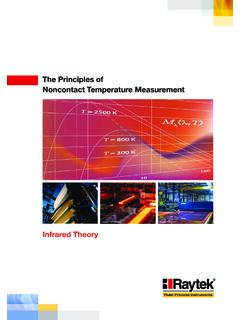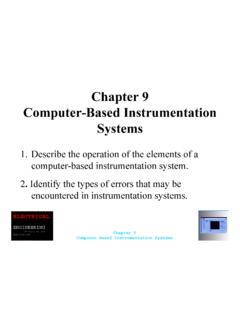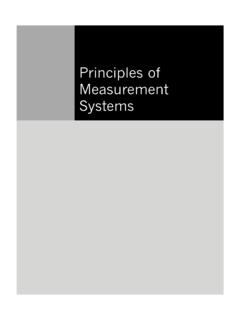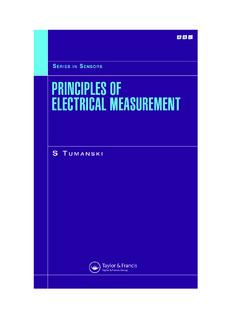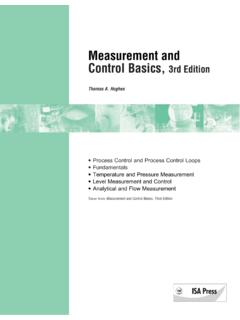Transcription of Principles of the Global Positioning System, Lecture 6
1 Principles of the Global Positioning system Lecture 06 Prof. Thomas Herring ~ GPS Observables Today s class we start discussing the nature of GPS observables and the methods used to make range and phase measurements Start with idea of remotely measuring distances Introduce range measurement systems and concepts used in graphically representingelectromagnetic signals Any questions on homework? 02/22/12 Lec 06 2 Distance measurement What are some of the methods used to measure distance?
2 We have talked about: Direct measurement with a ruler Inferred distances by measuring angles in triangles Distance measurement using the speed of light(light propagation time) GPS methods is related to measuring light propagation time but not directly. 02/22/12 Lec 06 3 Direct light propagation time Distance can be measured directly by sending a pulse and measuring how it takes to travel between two points. Most common method is to reflect the signal and the time between when the pulse was transmitted and when the reflected signal returns.
3 system used in radar and satellite laser ranging 02/22/12 Lec 06 4 Direct light propagation delay To measure a distance to 1 mm requires timing accuracy of 3x10-12 seconds (3 picoseconds) Timing accuracy needs to be maintained over the flight time . For satellite at 1000km distance, this is 3 millisecond. Clock stability needed 3ps/3ms = 10-9 A clock with this longtime stability would gain or lose seconds in a year (10-9*86400*365) (Clock short term and long term stabilities are usually very different -- Characterized by Allan Variance) 02/22/12 Lec 06 5 Direct light propagation measurement The noise in measuring the time will be proportional the duration of the pulse For mm-level measurements, need a pulse of the duration equivalent of a few millimeters.
4 Pulse strength also enters (you need to be able to detect the return pulse). In general, direct time measurement needs expensive equipment. A laser system capable of mm-level ranging to satellites costs ~$1M 02/22/12 Lec 06 6 Reflecting the signal back With optical (laser) systems you want to reflect signal back: a plain mirror won t do this unless perfectly normal to ray. Use a corner cube reflector. In 2-D shown on next page For satellites, need to spoil the cube ( , corner not exactly 90 degrees because station not where it was when signal transmitted) 02/22/12 Lec 06 7 Corner cube reflector The return angle is twice the corner angle For 90 degree corner, return is 180 degrees.
5 02/22/12 Lec 06 8 Alternative way to measure distance Instead of generating a short pulse and measuring round trip propagation time (also requires return pulse be detected), you can measure phase difference between outgoing and incoming continuous wave Schematic shown on next page Basic method used by interferometer 02/22/12 Lec 06 9 Difference measurement (stays constant with time and depends on distance) 02/22/12 Lec 06 10 Higher frequency. Phase difference still says something about distance but how to know number of cycles?
6 02/22/12 Lec 06 11 Mathematics behind this In an isotropic medium a propagating electromagnetic wave can be written as: i( t 2 ) E0e i2 ( ft )E(t,x) E0e Where E is the vector electric field, t is time, x is position and k is wave-vector (unit vector in direction of propagation divided by wavelength = velocity of light/frequency is frequency in radians/second, f is frequency in cycles/second. 02/22/12 Lec 06 12 Basic mathematics When an antenna is placed in the electric field (antenna in this case can be as simple as a piece of wire), the E-field induces a voltage difference between parts of the antenna that can be measured and amplified For static receiver and antenna, the voltage V is V (t) GE0ei2 0 e i t GE0ei2 0 e i2 ft G is gain of antenna.)
7 The phase of signal is 2 02/22/12 Lec 06 13 Basic Mathematics The use of complex notation in EM theory is interpretation is that the real part of the complexsignal is what is measured To recover the phase, we multiple the returned signalby the outgoing signal (beating the two signalstogether) Take the outgoing signal to be Vocos(2 ft) You also generate a /2 lagged version Vosin(2 ft) These are called quadrature channels and they aremultiplied by the returning signal 02/22/12 Lec 06 14 Basic Mathematics Using trigonometric identities.
8 Re(e ia cosb) cos acosb 12 cos(a b) cos(a b) Im(e ia cosb) sin acosb 12 sin(a b) sin(a b) Using these relationships we can derive the output obtained by multiplying by cos and sin versions of the outgoing signal are V (t)cos2 ft 12GE0[cos2 cos(2 4 ft)] V (t)sin2 ft 12GE0[sin2 sin(2 4 ft)] 02/22/12 Lec 06 15 Basic mathematics Notice the 4 ft term: this is twice the frequency of the original signal and by averaging the product over a period long compared to 1/f, this will average to zero The remaining terms are the cosine and sine of the phase This is an example of the modulation theorem of Fourier transforms 02/22/12 Lec 06 16 Phasor Diagrams These cosine and sine output are often represented in EM theory by phasor diagrams In this case it would look like.
9 02/22/12 Lec 06 17 Phase measurement of distance Phase difference between outgoing and incoming reflected tells something about distance If distance is less than 1 wavelength then unique answer But if more than 1 wavelength, then we need to number of integer cycles (return later to this for GPS). For surveying instruments that make this type of measurement , make phase difference measurements at multiple frequencies. (Often done with modulation on optical carrier signal). 02/22/12 Lec 06 18 Resolving ambiguities The range accuracy will be low for long-wavelength modulation: Rule of thumb: Phase can be measured to about 1% of wavelength For EDM: Use multiple wavelengths each shorter using longer wavelength to resolve integer cycles (example next slide) Using this method EDM can measure 10 s of km with millimeter precision 02/22/12 Lec 06 19 Ambiguity example A typical example would be.
10 Measure distances to 10 km using wavelengths of 20 km, 1 km, 200 m, 10 m, m True distance 11 m Wavelength Cycles Resolved Distance 20 km 11800 1 km 11790 200 m 11786 10 m 02/22/12 Lec 06 20 EDM basics and GPS For optical systems where reflection is from a mirror,this method works well For microwave, a simple reflector is difficult (radar). Most systems are active with the reflector receivingthe signal and re-transmitting it (transceiver) Satellite needs to know about ground systems Some systems work this way ( , DORIS) but it limits the number of ground stations GPS uses another method: One-way pseudorange measurement with bi-phase modulation (explainedlater) 02/22/12 Lec 06 21 GPS Methods Basic problem with conventional methods: Pulsed systems.










